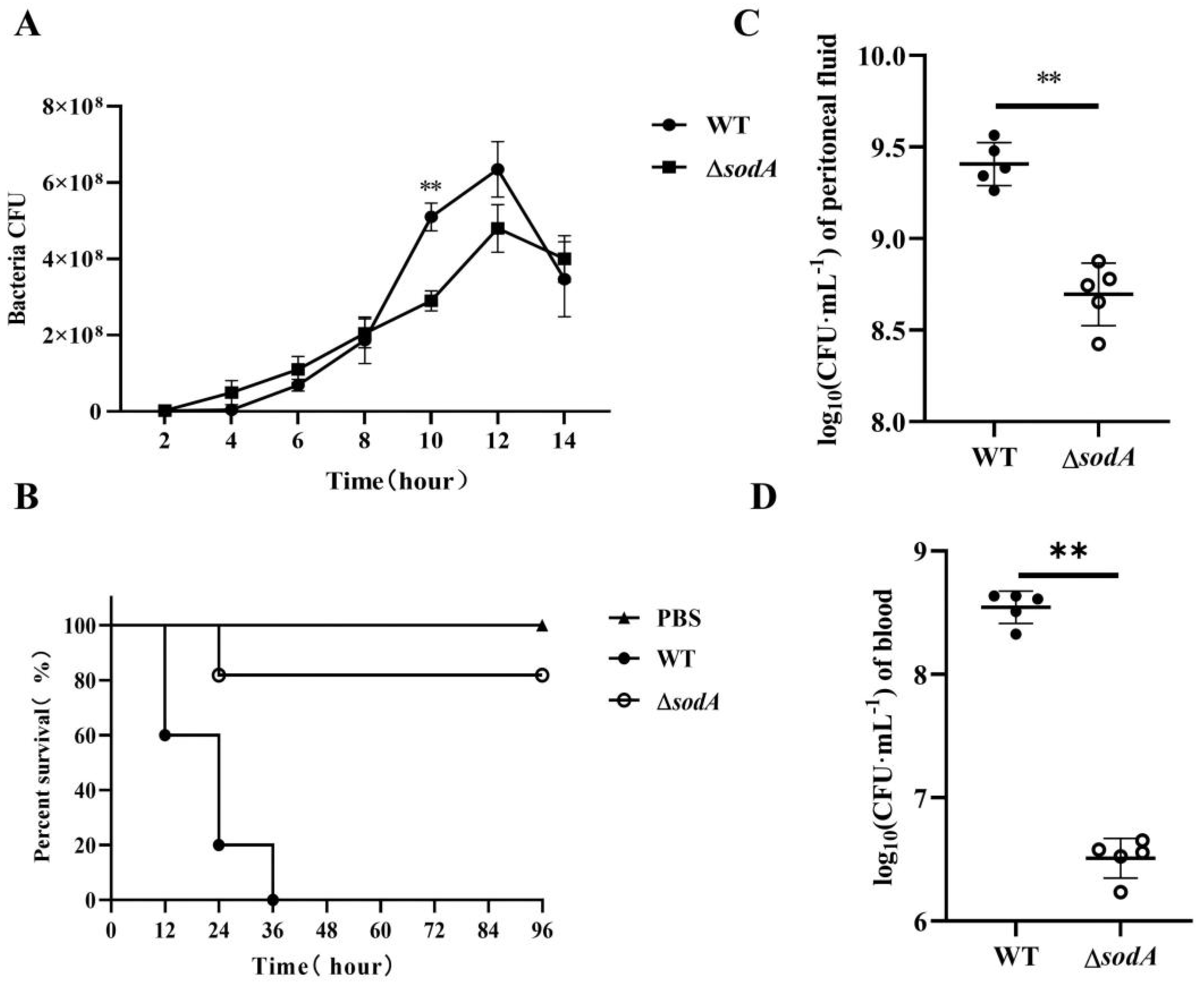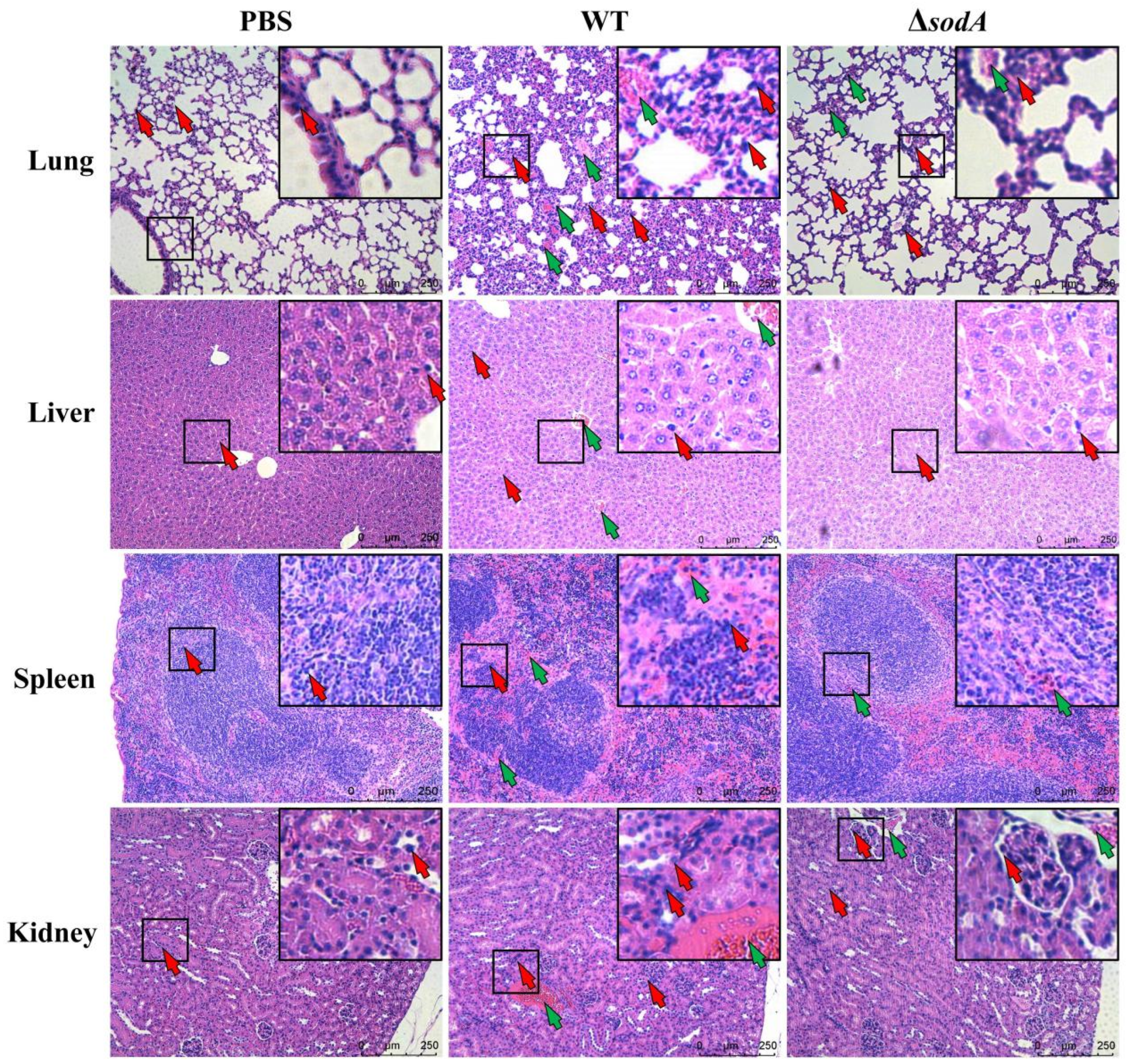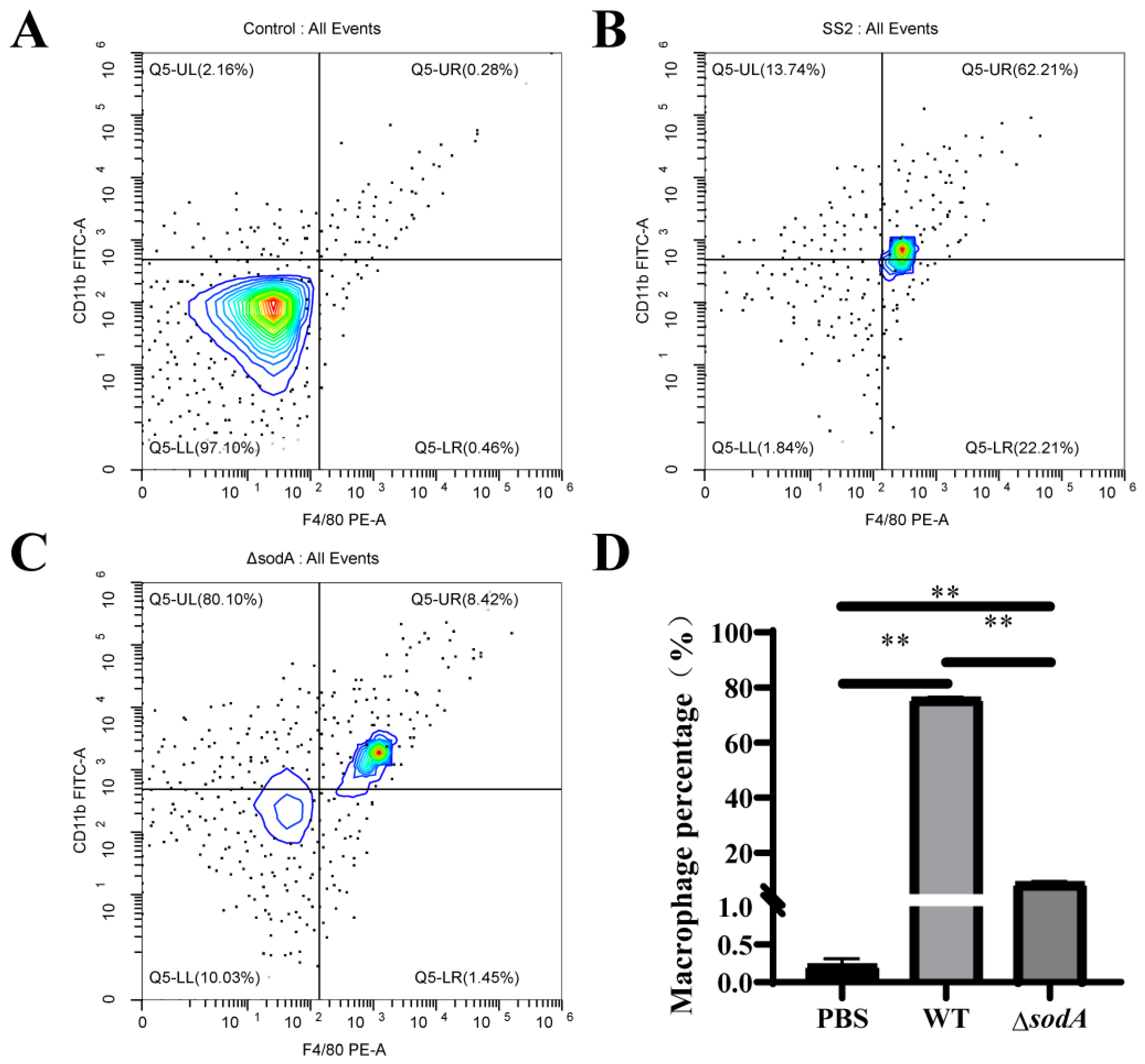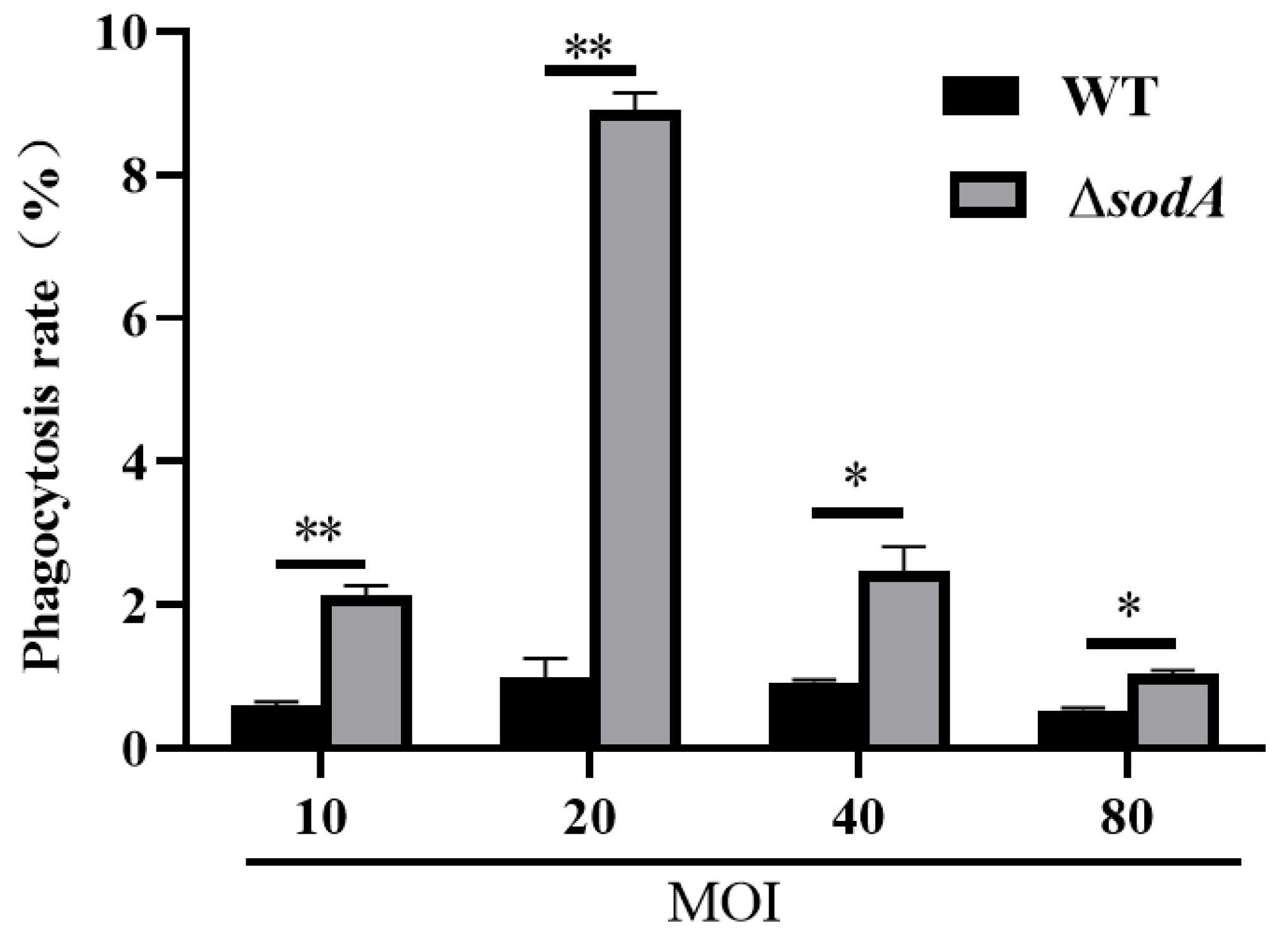Deletion of the sodA Gene Impaired the Pathogenicity of Streptococcus suis Serotype 2 to Mice by Inhibiting Caspase-1/GSDMD Pathway Activation in Macrophages
Abstract
1. Introduction
2. Materials and Methods
2.1. Mice Infection
2.2. Bacterial Loads
2.3. Tissue Histology Examination
2.4. Flow Cytometry and Western Blotting
2.5. Cytokine Assays
2.6. Statistical Analysis
3. Results
3.1. Deficiency of the sodA Gene Impaired the Pathogenicity of SS2 to Mice
3.2. Deficiency of the sodA Gene Alleviated Tissue Damage in Mice from SS2
3.3. Deficiency of the sodA Gene Decreased Bacterial Loads of SS2 in Mice
3.4. Deficiency of the sodA Gene Decreased Macrophage Infiltration in Mice Injected with SS2
3.5. Deficiency of the sodA Gene Impaired the Resistance to Phagocytosis and Killing in Macrophages
3.6. Deficiency of the sodA Gene Alleviated the Caspase-1/GSDMD Pathway in Macrophages Induced by SS2
3.7. Deficiency of the sodA Gene Reduced Inflammatory Cytokine Release in Macrophages Induced with SS2
4. Discussion
5. Conclusions
Author Contributions
Funding
Institutional Review Board Statement
Informed Consent Statement
Data Availability Statement
Conflicts of Interest
Abbreviations
| SS2 | Streptococcus suis serotype 2 |
| IL-1β | Interleukin-1 beta |
| IL-18 | Interleukin-18 |
| CFU | Colony forming unit |
| SOD | Superoxide dismutase |
| LDH | Lactate dehydrogenase |
References
- Payen, S.; Rrodriguez, J.A.; Segura, M.; Gottschalk, M. Laminin-binding protein of Streptococcus suis serotype 2 influences zinc acquisition and cytokine responses. Vet. Res. 2023, 54, 1. [Google Scholar] [CrossRef]
- Tan, M.F.; Tan, J.; Zhang, F.F.; Li, H.Q.; Ji, H.Y.; Fang, S.P.; Wu, C.C.; Rao, Y.L.; Zeng, Y.B.; Yang, Q. Exogenous glycogen utilization effects the transcriptome and pathogenicity of Streptococcus suis serotype 2. Front. Cell Infect. Microbiol. 2022, 12, 938286. [Google Scholar] [CrossRef] [PubMed]
- Wu, C.F.; Chen, S.H.; Chou, C.C.; Wang, C.M.; Huang, S.W.; Kuo, H.C. Serotype and multilocus sequence typing of Streptococcus suis from diseased pigs in Taiwan. Sci. Rep. 2023, 13, 8263. [Google Scholar] [CrossRef]
- Meng, Y.; Lin, S.; Niu, K.; Ma, Z.; Lin, H.; Fan, H. Vimentin affects inflammation and neutrophil recruitment in airway epithelium during Streptococcus suis serotype 2 infection. Vet. Res. 2023, 54, 7. [Google Scholar] [CrossRef]
- Niu, K.; Meng, Y.; Liu, M.; Ma, Z.; Lin, H.; Zhou, H.; Fan, H. Phosphorylation of GntR reduces Streptococcus suis oxidative stress resistance and virulence by inhibiting NADH oxidase transcription. PLoS Pathog. 2023, 19, e1011227. [Google Scholar] [CrossRef]
- Jiang, H.; Sun, Y.; Li, F.; Yu, X.; Lei, S.; Du, S.; Wu, T.; Jiang, X.; Zhu, J.; Wang, J.; et al. Enolase of Streptococcus suis serotype 2 promotes biomolecular condensation of ribosomal protein SA for HBMECs apoptosis. BMC Biol. 2024, 22, 33. [Google Scholar] [CrossRef]
- Gauthier, T.; Chen, W. Modulation of macrophage immunometabolism: A new approach to fight infections. Front. Immunol. 2022, 13, 780839. [Google Scholar] [CrossRef]
- Ahmad, F.; Rani, A.; Alam, A.; Zarin, S.; Pandey, S.; Singh, H.; Hasnain, S.E.; Ehtesham, N.Z. Macrophage: A cell with many faces and functions in tuberculosis. Front. Immunol. 2022, 13, 747799. [Google Scholar] [CrossRef] [PubMed]
- Fang, S.; Wan, X.; Zou, X.; Sun, S.; Hao, X.; Liang, C.; Zhang, Z.; Zhang, F.; Sun, B.; Li, H.; et al. Arsenic trioxide induces macrophage autophagy and atheroprotection by regulating ROS-dependent TFEB nuclear translocation and AKT/mTOR pathway. Cell Death Dis. 2021, 12, 88. [Google Scholar] [CrossRef] [PubMed]
- Herb, M.; Schramm, M. Functions of ROS in macrophages and antimicrobial immunity. Antioxidants 2021, 10, 313. [Google Scholar] [CrossRef]
- Sharma, K.K.; Singh, D.; Mohite, S.V.; Williamson, P.R.; Kennedy, J.F. Metal manipulators and regulators in human pathogens: A comprehensive review on microbial redox copper metalloenzymes “multicopper oxidases and superoxide dismutases”. Int. J. Biol. Macromol. 2023, 233, 123534. [Google Scholar] [CrossRef] [PubMed]
- Lv, H.; Li, X.; Peng, Q.; Niu, X.; Meng, C.; Niu, L.; Zhang, S.; Li, P.; Jiao, H.; Wang, Z.; et al. SodC is responsible for oxidative stress resistance and pathogenicity of Corynebacterium pseudotuberculosis, and the sodC-deleted C. pseudotuberculosis vaccine provides immunity in mice. Vet. Microbiol. 2025, 304, 110484. [Google Scholar] [CrossRef] [PubMed]
- Chen, H.; Zhang, J.; He, Y.; Lv, Z.; Liang, Z.; Chen, J.; Li, P.; Liu, J.; Yang, H.; Tao, A.; et al. Exploring the role of Staphylococcus aureus in inflammatory diseases. Toxins 2022, 14, 464. [Google Scholar] [CrossRef] [PubMed]
- Robinson, N.; Ganesan, R.; Hegedus, C.; Kovacs, K.; Kufer, T.A.; Virag, L. Programmed necrotic cell death of macrophages: Focus on pyroptosis, necroptosis, and parthanatos. Redox Biol. 2019, 26, 101239. [Google Scholar] [CrossRef]
- Wang, S.; Wang, G.; Tang, Y.D.; Li, S.; Qin, L.; Wang, M.; Yang, Y.B.; Gottschalk, M.; Cai, X. Streptococcus suis serotype 2 infection induces splenomegaly with splenocyte apoptosis. Microbiol. Spectr. 2022, 10, e0321022. [Google Scholar] [CrossRef]
- Song, L.; Li, X.; Xiao, Y.; Huang, Y.; Jiang, Y.; Meng, G.; Ren, Z. Contribution of Nlrp3 inflammasome activation mediated by suilysin to streptococcal toxic shock-like syndrome. Front. Microbiol. 2020, 11, 1788. [Google Scholar] [CrossRef]
- Fang, L.; Shen, H.; Tang, Y.; Fang, W. Superoxide dismutase of Streptococcus suis serotype 2 plays a role in anti-autophagic response by scavenging reactive oxygen species in infected macrophages. Vet. Microbiol. 2015, 176, 328–336. [Google Scholar] [CrossRef]
- Zhu, K.; Hill, W.G.; Li, F.; Shi, B.; Chai, T.C. Urine and tissue bacterial loads correlate with voiding behaviors in a murine urinary tract infection model. Urology 2021, 154, e1–e344. [Google Scholar] [CrossRef]
- Chen, X.; Wu, R.; Li, L.; Zeng, Y.; Chen, J.; Wei, M.; Feng, Y.; Chen, G.; Wang, Y.; Lin, L.; et al. Pregnancy-induced changes to the gut microbiota drive macrophage pyroptosis and exacerbate septic inflammation. Immunity 2023, 56, 336–352.e9. [Google Scholar] [CrossRef]
- Li, S.; Sun, Y.; Song, M.; Song, Y.; Fang, Y.; Zhang, Q.; Li, X.; Song, N.; Ding, J.; Lu, M.; et al. NLRP3/caspase-1/GSDMD-mediated pyroptosis exerts a crucial role in astrocyte pathological injury in mouse model of depression. JCI Insight 2021, 6, e146852. [Google Scholar] [CrossRef]
- Dumesnil, A.; Auger, J.P.; Roy, D.; Votsch, D.; Willenborg, M.; Valentin-Weigand, P.; Park, P.W.; Grenier, D.; Fittipaldi, N.; Harel, J.; et al. Characterization of the zinc metalloprotease of Streptococcus suis serotype 2. Vet. Res. 2018, 49, 109. [Google Scholar] [CrossRef]
- Shen, X.; Liu, H.; Li, G.; Deng, X.; Wang, J. Silibinin attenuates Streptococcus suis serotype 2 virulence by targeting suilysin. J. Appl. Microbiol. 2019, 126, 435–442. [Google Scholar] [CrossRef]
- Zhu, X.; Wang, S.; Du, Y.; Liang, Z.; Yao, H.; Chen, X.; Wu, Z. A novel aquaporin Aagp contributes to Streptococcus suis H2O2 efflux and virulence. Virulence 2023, 14, 2249789. [Google Scholar] [CrossRef]
- Qin, S.; Xiao, W.; Zhou, C.; Pu, Q.; Deng, X.; Lan, L.; Liang, H.; Song, X.; Wu, M. Pseudomonas aeruginosa: Pathogenesis, virulence factors, antibiotic resistance, interaction with host, technology advances and emerging therapeutics. Signal Transduct. Target. Ther. 2022, 7, 199. [Google Scholar] [CrossRef]
- Zhang, X.; Jiang, X.; Yang, L.; Fang, L.; Shen, H.; Lu, X.; Fang, W. DnaJ of Streptococcus suis type 2 contributes to cell adhesion and thermotolerance. J. Microbiol. Biotechnol. 2015, 25, 771–781. [Google Scholar] [CrossRef] [PubMed]
- El, S.H.; Ghanem, S. Regulation of expression of sodA and msrA genes of corynebacterium glutamicum in response to oxidative and radiative stress. Genet. Mol. Res. 2015, 14, 2104–2117. [Google Scholar] [CrossRef]
- Xu, M.; Lyu, Y.; Cheng, K.; Zhang, B.; Cai, Z.; Chen, G.; Zhou, J. Interactions between quorum sensing/quorum quenching and virulence genes may affect coral health by regulating symbiotic bacterial community. Environ. Res. 2023, 238, 117221. [Google Scholar] [CrossRef]
- Ng, H.F.; Ngeow, Y.F. A single-gene approach for the subspecies classification of Mycobacteroides abscessus. Pathog. Dis. 2020, 78, ftaa055. [Google Scholar] [CrossRef]
- Pidwill, G.R.; Gibson, J.F.; Cole, J.; Renshaw, S.A.; Foster, S.J. The role of macrophages in Staphylococcus aureus infection. Front. Immunol. 2020, 11, 620339. [Google Scholar] [CrossRef] [PubMed]
- Liu, H.; Lei, S.; Jia, L.; Xia, X.; Sun, Y.; Jiang, H.; Zhu, R.; Li, S.; Qu, G.; Gu, J.; et al. Streptococcus suis serotype 2 enolase interaction with host brain microvascular endothelial cells and RPSA-induced apoptosis lead to loss of BBB integrity. Vet. Res. 2021, 52, 30. [Google Scholar] [CrossRef] [PubMed]
- Locati, M.; Curtale, G.; Mantovani, A. Diversity, mechanisms, and significance of macrophage plasticity. Annu. Rev. Pathol. 2020, 15, 123–147. [Google Scholar] [CrossRef]
- Ebenezer, D.L.; Fu, P.; Suryadevara, V.; Zhao, Y.; Natarajan, V. Epigenetic regulation of pro-inflammatory cytokine secretion by sphingosine 1-phosphate (S1P) in acute lung injury: Role of S1P lyase. Adv. Biol. Regul. 2017, 63, 156–166. [Google Scholar] [CrossRef]
- Voss, O.H.; Murakami, Y.; Pena, M.Y.; Lee, H.N.; Tian, L.; Margulies, D.H.; Street, J.M.; Yuen, P.S.; Qi, C.F.; Krzewski, K.; et al. Lipopolysaccharide-induced CD300b receptor binding to toll-like receptor 4 alters signaling to drive cytokine responses that enhance septic shock. Immunity 2016, 44, 1365–1378. [Google Scholar] [CrossRef]
- Stender, J.D.; Nwachukwu, J.C.; Kastrati, I.; Kim, Y.; Strid, T.; Yakir, M.; Srinivasan, S.; Nowak, J.; Izard, T.; Rangarajan, E.S.; et al. Structural and molecular mechanisms of cytokine-mediated endocrine resistance in human breast cancer cells. Mol. Cell 2017, 65, 1122–1135.e5. [Google Scholar] [CrossRef]
- Tang, Y.; Zhang, X.; Wu, W.; Lu, Z.; Fang, W. Inactivation of the sodA gene of Streptococcus suis type 2 encoding superoxide dismutase leads to reduced virulence to mice. Vet. Microbiol. 2012, 158, 360–366. [Google Scholar] [CrossRef]
- Shi, J.; Gao, W.; Shao, F. Pyroptosis: Gasdermin-mediated programmed necrotic cell death. Trends Biochem. Sci. 2017, 42, 245–254. [Google Scholar] [CrossRef]
- Xiaodong, L.; Xuejun, X. GSDMD-mediated pyroptosis in retinal vascular inflammatory diseases: A review. Int. Ophthalmol. 2023, 43, 1405–1411. [Google Scholar] [CrossRef] [PubMed]
- Miao, R.; Jiang, C.; Chang, W.Y.; Zhang, H.; An, J.; Ho, F.; Chen, P.; Zhang, H.; Junqueira, C.; Amgalan, D.; et al. Gasdermin D permeabilization of mitochondrial inner and outer membranes accelerates and enhances pyroptosis. Immunity 2023, 56, 2523–2541.e8. [Google Scholar] [CrossRef] [PubMed]
- Coll, R.C.; Schroder, K.; Pelegrin, P. NLRP3 and pyroptosis blockers for treating inflammatory diseases. Trends Pharmacol. Sci. 2022, 43, 653–668. [Google Scholar] [CrossRef] [PubMed]
- Sun, L.; Ma, W.; Gao, W.; Xing, Y.; Chen, L.; Xia, Z.; Zhang, Z.; Dai, Z. Propofol directly induces caspase-1-dependent macrophage pyroptosis through the NLRP3-ASC inflammasome. Cell Death Dis. 2019, 10, 542. [Google Scholar] [CrossRef]
- Kang, R.; Zeng, L.; Zhu, S.; Xie, Y.; Liu, J.; Wen, Q.; Cao, L.; Xie, M.; Ran, Q.; Kroemer, G.; et al. Lipid peroxidation drives Gasdermin D-mediated pyroptosis in lethal polymicrobial sepsis. Cell Host Microbe 2018, 24, 97–108.e4. [Google Scholar] [CrossRef] [PubMed]







Disclaimer/Publisher’s Note: The statements, opinions and data contained in all publications are solely those of the individual author(s) and contributor(s) and not of MDPI and/or the editor(s). MDPI and/or the editor(s) disclaim responsibility for any injury to people or property resulting from any ideas, methods, instructions or products referred to in the content. |
© 2025 by the authors. Licensee MDPI, Basel, Switzerland. This article is an open access article distributed under the terms and conditions of the Creative Commons Attribution (CC BY) license (https://creativecommons.org/licenses/by/4.0/).
Share and Cite
Li, Y.; Fang, Q.; Feng, P.; Li, Y.; Sun, Q.; Huang, Y.; Li, S.; Olaolu, O.A.; Fu, Q. Deletion of the sodA Gene Impaired the Pathogenicity of Streptococcus suis Serotype 2 to Mice by Inhibiting Caspase-1/GSDMD Pathway Activation in Macrophages. Microorganisms 2025, 13, 2566. https://doi.org/10.3390/microorganisms13112566
Li Y, Fang Q, Feng P, Li Y, Sun Q, Huang Y, Li S, Olaolu OA, Fu Q. Deletion of the sodA Gene Impaired the Pathogenicity of Streptococcus suis Serotype 2 to Mice by Inhibiting Caspase-1/GSDMD Pathway Activation in Macrophages. Microorganisms. 2025; 13(11):2566. https://doi.org/10.3390/microorganisms13112566
Chicago/Turabian StyleLi, Yajuan, Qiuguo Fang, Peiran Feng, Yushu Li, Qinqin Sun, Yunfei Huang, Shun Li, Oladejo Ayodele Olaolu, and Qiang Fu. 2025. "Deletion of the sodA Gene Impaired the Pathogenicity of Streptococcus suis Serotype 2 to Mice by Inhibiting Caspase-1/GSDMD Pathway Activation in Macrophages" Microorganisms 13, no. 11: 2566. https://doi.org/10.3390/microorganisms13112566
APA StyleLi, Y., Fang, Q., Feng, P., Li, Y., Sun, Q., Huang, Y., Li, S., Olaolu, O. A., & Fu, Q. (2025). Deletion of the sodA Gene Impaired the Pathogenicity of Streptococcus suis Serotype 2 to Mice by Inhibiting Caspase-1/GSDMD Pathway Activation in Macrophages. Microorganisms, 13(11), 2566. https://doi.org/10.3390/microorganisms13112566





